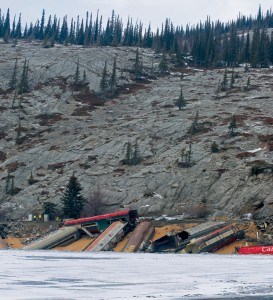
The clean up of a derailment near the east gate of Jasper National Park continues, more than a month after 12 CN cars carrying grain derailed spilling their contents into the Athabasca River.
According to Parks Canada, 500 tonnes of grain had been recovered as of Jan. 3.
“Parks Canada is continuing to monitor the cleanup from the recent derailment,” wrote Steve Young, a communications officer for Jasper National Park, in an email.
“CN is responsible for the cleanup effort and has enlisted the help of an environmental consulting firm to oversee the operation.”
According to CN, the cleanup is dependent upon the weather and there is no set timeline for completion.
“Work continues to clean up the spilled grain and remove the remaining grain cars. CN environment officers and Parks Canada officials are working collaboratively to protect the safety of the wildlife in the park near the scene,” wrote Brent Kossey, a senior spokesperson for the company.
Kossey did not respond to a follow up email asking how much grain was initially spilled.
On Dec. 10, 12 CN railcars derailed west of a small train tunnel at Bedson Ridge, which delineates the park’s eastern boundary.
There were no injuries or dangerous goods involved, although six cars were left partially submerged in the Athabasca River with a substantial amount of grain spilled on the embankment.
It was the second derailment to occur in the area in five days and forced CN to close the track until the following morning.
According to CN, on Dec. 6 a CN car derailed in the same vicinity, but managed to stay upright with one set of wheels off the track.
Upon news of the second, more serious derailment, the Transportation Safety Board of Canada (TSB) sent an investigator to the scene to determine the cause of the accident.
The board has since deemed it a “class-five” occurrence and will not be investigating the cause of the accident any further.
“We won’t be doing a full report on it. All we’re going to be doing is gathering data for statistical purposes,” said Eric Collard, a spokesperson for TSB.
“Basically what it comes down to is if we can’t further transportation safety by studying this one then there’s not going to be a full investigation. We have thousands of occurrences throughout the country every year so we have to pick the ones where we can learn the most about how we can actually help transportation safety in Canada.”
According to the TSB’s website, approximately 4,000 marine, pipeline, rail and aviation occurrences are reported to the board every year and only a small portion are investigated.
The primary criterion for determining if an occurrence will be investigated is whether or not such an investigation is likely to reduce the risk to people, property, or the environment.
To determine this, the agency uses a scale from one to five, with class-one leading to a full-scale investigation and public inquiry.
By deeming the Dec. 10 derailment a class-five occurrence, it suggests the board didn’t find the two derailments in the same area warranted further investigation.
According to the board’s website, a class-four investigation is launched when multiple occurrences happen and the board deems the accidents “to be indicative of significant unsafe situations or conditions.”
Two factors critical to launching a class-four investigation include a high probability the investigation will advance Canadian transportation safety and if, in the board’s opinion, there is widespread public expectation that it independently analyze a particular safety issue.
Paul Clarke
[email protected]
